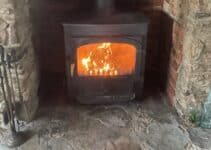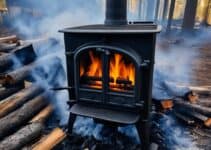As an enthusiast of the cosy warmth that log burners provide, I appreciate the subtle nuances that contribute to their efficiency and safety. Chief among these is selecting the appropriate log burner door seal size, which remains integral to the appliance’s performance. When the time comes to replace the rope seal of the wood stove door, I make it my priority to choose the correct wood stove rope size. Doing so ensures not only the longevity of the stove but also the comfort and satisfaction of my home.
My approach entails a meticulous examination of the current rope when the stove is at rest and cold. I gently extricate the existing rope, cautious to keep its structural integrity intact, and then endeavour to restore it to its original round shape – a shape often compromised after prolonged utility. What follows is a precise measurement, taken with a ruler or tape measure, reflective of the rope’s diameter in millimetres – a critical figure that informs my subsequent decision.
In my pursuit of the ideal fit, I distinguish between the standard and soft rope types, acknowledging that each offers unique benefits tailored to individual preferences and specifications. The adventure of determining the perfect fit is one I relish, knowing that the result will be a log burner that operates at peak proficiency, providing warmth and comfort through the coldest of winters.
Understanding the Importance of the Correct Rope Size for Log Burners
As I delve into the significance of choosing the right log burner rope size, it becomes evident that the function of the stove rope extends far beyond a mere component; it’s an essential element for maintaining your wood burning stove’s efficiency and safety. Ensuring you have the correct rope thickness for your log burner is fundamental for the longevity and performance of your heating appliance.
Role of Stove Rope in Maintaining an Airtight Seal
Achieving an airtight seal is pivotal for the optimal functioning of a log burner. The stove rope serves as a crucial barrier, reducing the influx of excess air that could potentially alter the combustion within the firebox. Optimal rope size for a wood burning stove not only prevents over-firing but also keeps the glass clear from soot accumulation, preserving the clean aesthetic and functionality of your log burner.
Consequences of a Poorly Sized Rope on Burner Efficiency
When the seal integrity is compromised due to an incorrect stove rope diameter, the repercussions are immediate and detrimental. An ill-fitting seal can manifest in the inability to control the fire’s intensity. This leads to an inefficient burn, increased fuel consumption, and escalated costs. Furthermore, log burner safety is compromised, with the risk of smoke leaking into living spaces.
| Stove Rope Property | Effect on Log Burner Performance |
|---|---|
| Rope Diameter is Too Small | Inadequate Seal Leading to Increased Air Intake and Over-Firing |
| Incorrect Rope Thickness | Reduced Efficiency and Potential Glass Blackening |
| Rope Diameter is Too Large | Difficulty Closing the Door Fully, Compromising the Seal Quality |
| Properly Sized Stove Rope | Optimal Combustion Control and Efficient Fuel Use |
Understanding the pivotal role and potential consequences of rope size is foundational to the care and operation of a wood burning stove. Next time you inspect your appliance, consider the rope’s condition, and if necessary, select the appropriate log burner rope size to maintain an efficient, safe, and cost-effective heat source.
Identifying When to Replace Your Log Burner Rope
Maintaining your wood burning stove in prime condition requires a keen eye for detail and an understanding of when components need attention. One such component crucial to the efficiency of your log burner is the stove rope—a simple but essential part of your stove’s anatomy. As someone who values the operability and safety of my wood burning stove, I know the importance of the log burner door rope size and its timely replacement.
Signs of Wear and Tear in Existing Stove Ropes
I routinely inspect my stove rope for signs of deterioration, such as fraying or noticeable flattening, which often means the seal’s integrity is compromised. If the rope appears to have lost its resilience, often indicated by an increased draw of air or the presence of tar deposits around the seal area, it is likely time to measure up for a new log burner gasket size or rope diameter.
Recommended Frequency of Rope Inspection and Replacement
I advise a thorough inspection of the rope seal on at least an annual basis. This practice not only catches early signs of wear but aligns with the general maintenance schedule for wood burning stoves. Should your stove exhibit loud operation or the glass becomes regularly blackened, it might suggest the rope diameter doesn’t snugly fit its seating, thus necessitating a more prompt replacement. Knowing the correct log burner door rope diameter ensures the replacement will reinstate your stove’s efficiency and safety without delay.
Remember, the rope size for wood burning stove is not a mere detail; it is a critical aspect that can mean the difference between a well-functioning and a suboptimal burner. My experience has taught me that proactive management in rope maintenance not only extends the life of your stove but also maximizes your comfort and peace of mind.
Measuring the Diameter of Your Log Burner Rope
When I’m confronted with the task of replacing a stove rope seal, I first focus on determining the precise log burner rope size. Necessary to ensuring an effective seal, acquiring the dimension of an existing, yet undamaged part of the rope, is essential. If the manual falls short in providing guidance, I resort to assessing the unworn section of the old gasket. Should the gasket be uniformly worn or the manual be unavailable, comparing the channel’s depth and width against the old rope presents a reliable alternative.
As I measure the uncompressed rope, I am careful to utilise either a ruler or tape measure, ensuring the final reading is in millimetres. To further elucidate my point, I have crafted a table to exemplify the types of measurements that one might encounter:
| Rope Condition | Measuring Approach | Tools Used | Common Sizes (mm) |
|---|---|---|---|
| Newly Unpacked Rope | Measure diameter directly | Ruler or tape measure | 6, 8, 10 |
| Compressed/Worn Rope | Reshape and measure diameter | Ruler or tape measure | 6, 8, 10 |
| Gasket Channel Measurement | Compare channel width and depth | Ruler or calipers | Depends on stove model |
Keep in mind the diversity of what size rope for log burner options. The most common sizes fall within the range of 6 to 10 millimetres, yet this is largely contingent on the specifications of your particular burner model. Therefore, verifying the requisite size before purchasing is paramount. By meticulously following these guidelines, one can assiduously achieve a log burner that not only operates at peak efficiency but is also underpinned by robust safety standards.
Choosing the Correct Type of Rope for Your Log Burner
When it comes time to select a rope for your wood burning stove, understanding the types available and their specific attributes is imperative. The proper rope size for wood burning stove not only aids in maintaining an efficient burn but also recognizes the unique needs of your log burner’s design.
Differences between Standard and Soft Rope
The distinction between standard and soft rope essentially boils down to weave density and pliability. Let me explain: a standard rope possesses a high weave density, giving it the rigidity akin to pressing a finger into solid ground—a testament to its durability. Conversely, soft log burner door rope offers a gentler, more malleable feel due to its loose weave, not unlike squeezing a soft toy. The tactile difference might seem minor, but it can have a substantial impact on installation and performance.
Heat Resistance and Material Considerations
In the realm of heat resistance, material choice is paramount. The fibreglass composition common in soft ropes is celebrated for enduring temperatures up to 1200°C, which, for perspective, trumps the heat inside typical log burners. This durability ensures that the rope can withstand the rigours of high-temperature cycles without degrading, thus upholding the seal of the log burner door for extended periods. It’s essential for ensuring your wood stove rope size remains consistent, eliminating the need for frequent adjustments or replacements.
Now, let’s delve into the nuances that determine an appropriate log burner door rope diameter, informed by the table I’ve prepared:
| Stove Model | Recommended Standard Rope Diameter | Recommended Soft Rope Diameter | Material Type |
|---|---|---|---|
| Compact Cast Iron Burner | 8mm | 6mm | Fibreglass |
| Large Steel Burner | 10mm | 8mm | Fibreglass |
| Modern High-Efficiency Burner | 12mm | N/A | Fibreglass |
| Antique Replica Stove | 10mm | 10mm | Fibreglass |
As you see, the log burner door seal size varies significantly, influenced by the design and manufacturing era of the appliance. To conclude, my experience tells me that the ideal wood stove rope size must balance flexibility with a snug fit, accommodating for variances in stove door construction while sustaining the necessitous airtight barrier against the belligerent force of the flames within. Choosing the proper log burner rope is about marrying the technical specifications of your burner with the appropriate rope characteristics for a harmonious, long-lasting, and safe burning experience.
Installation Tips for Log Burner Door and Glass Rope Seals
The task of fitting a new rope seal to a wood stove can be fraught with challenges. Correct log burner rope size is imperative for efficiency, and equally, the installation process demands precision. In my experience, preparation and the proper tools are your best allies in achieving a professional finish. I’d like to share some insight into cutting and securing stove rope effectively.
Challenges in Cutting and Fitting Stove Rope
Anyone who has attempted to cut rope to size knows the frustration of fraying ends. Fraying can cause an untidy finish and complicate the fitting process. The rope thickness for your log burner can either make this task easier or more troublesome. A thinner rope is more inclined to fray than a thicker one. To counteract this, I use high-temperature end tape. A couple of turns of this tape around the rope ends act as a barrier when cutting, ensuring a crisp, neat edge every time.
When measuring the rope to size, always allow extra length for minor errors and adjustments. Remember, it’s easier to snip a bit off than to add it on! For most stoves, a log burner gasket size of 10 to 15mm is standard, but always consult your manufacturer’s guide; the correct wood stove rope size is vital for an airtight seal.
Utilising High-Temperature Adhesives for a Professional Finish
A trick of the trade is to thoroughly clean the channel where the rope will sit. Removing old glue and debris ensures the new adhesive bonds well. I always opt for a high-temperature silicone adhesive, which resists the intense heat a stove generates. Accurate measurement of the log burner rope size is key; it needs to fit snugly within the door’s recess without stretching or bunching.
When placing the rope, I make a point to align the ends perfectly to avoid potential gaps. The high-temperature adhesive not only secures the rope in place but also helps maintain the integrity of the seal during use. A steady hand and patience will result in a seal as good as any professional could provide, ensuring your log burner operates safely and efficiently for years to come.
Conclusion
In summarising, my experiences emphasize the criticality of opting for the precise rope size for wood burning stove maintenance. Such attention to detail underpins not only the safety parameters of your log burner but also contributes to its efficiency and longevity. My encounters highlight that routine inspections allied with prompt replacement of deteriorated stove ropes are not simply a matter of procedure but an integral component of responsible appliance stewardship.
Throughout this discourse, I’ve underlined the essence of measuring accurately to ascertain what size rope for log burner is required. Ensuring accuracy at this stage circumvents the pitfalls of operational inefficiency and potential security risks. I cannot stress enough the importance of employing high-quality adhesives, which serve as the linchpin for a robust and enduring installation. The methodical installation of a correctly sized rope ensures that your log burner functions at its optimal capacity.
In conclusion, recognising and implementing the correct rope size for your log burner is a nuanced process that demands attention and precision. Through reflective practice and adherence to the advice shared within this article, I trust you’ll be empowered to maintain your log burner with the utmost confidence, secure in the knowledge that your appliance operates safely and efficiently.



